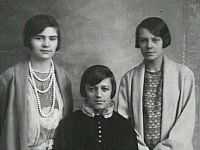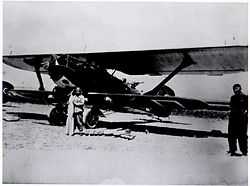Sabiha Gökçen
| Sabiha Gökçen | |
|---|---|
 | |
| Born |
22 March 1913 Bursa, Ottoman Empire |
| Died |
22 March 2001 (aged 88) Ankara, Turkey |
| Occupation | Aviatrix, author and spokesperson |
| Known for | First woman to fly during conflict. |
| Parents | Mustafa İzzet Bey and Hayriye Hanım |
Sabiha Gökçen (Turkish: [sabiha ɡøkt͡ʃen]; March 22, 1913 – March 22, 2001) was a Turkish aviator. According to the Air University, she was the world's first female fighter pilot,[1] and the first Turkish female combat pilot, aged 23.[2] She was one of the eight adopted children of Mustafa Kemal Atatürk.
Early life


According to interviews with Sabiha Gökçen, she was the daughter of Mustafa Izzet Bey and Hayriye Hanım. During Atatürk's visit to Bursa in 1925, Sabiha, who was only 12 years old, asked for permission to talk with Atatürk and expressed her wish to study in a boarding school. After learning her story and about her miserable living conditions, Atatürk decided to adopt her and asked Sabiha's brother for permission to take her to the Çankaya Presidential Residence in Ankara, where Sabiha would live among Atatürk's other adoptive daughters, Zehra, Afet and Rukiye. Sabiha attended the Çankaya Primary School in Ankara and the Üsküdar Girls' College in Istanbul.
Just after the introduction of the surname act, Atatürk gave her the family name Gökçen on December 19, 1934. Gök means sky in Turkish and Gökçen means 'belonging or relating to the sky'. However, she was not an aviator at the date,[3] and it was only six months later that Sabiha developed a passion for flying. Along with her, Gökçen Efe (who was one of the Zeybek's fighter against Greek invasion movement fighting with Celal Bayar) left her children to Celal Bayar when he died. Since He (Gökçen Efe) was quite loved by Celal Bayar, the same surname was given to Sabiha, along with two children of Gökçen Efe, according to family sources. She has her own airport in Turkey named after her.
Career


Atatürk attached great importance to aviation and for that purpose, oversaw the foundation of the Turkish Aeronautical Association in 1925. He took Sabiha along with him to the opening ceremony of Türkkuşu (Turkishbird) Flight School on May 5, 1935. During the airshow of gliders and parachutists invited from foreign countries, she got very excited. As Atatürk asked her whether she would also want to become a skydiver, she nodded "yes indeed, I am ready right now". Atatürk instructed Fuat Bulca, the head of the school, to enroll her as the first female trainee. She should have become a skydiver, however she was much more interested in flying, so she received her pilot's licence. Gökçen was sent to Russia, together with seven male students, for an advanced course in glider and powered aircraft piloting. However, when she was in Moscow, she learned the news that Zehra had died, and with collapsed morale, she immediately returned to Turkey, isolating herself from social activities for some time.
In the beginning of 1936, Atatürk urged her to attend the Air Force Academy[citation needed] to become the first female military pilot of Turkey. She improved her skills by flying bomber and fighter planes at the 1st Aircraft Regiment in Eskişehir Airbase and got experience after participating in the Aegean and Thrace exercises in 1937. In that same year, she took part in the military operation against the Dersim rebellion and became the first Turkish female air force combat pilot. A report of the General Staff mentioned the "serious damage" that had been caused by her 50 kg bomb, upon a group of 50 fleeing "bandits."[4] She was also awarded the Turkish Aeronautical Association's first "Jeweled Medal" due to her superior performance in this operation.[1]
In 1938, she carried out a five-day flight around the Balkan countries to great acclaim. Later, she was appointed chief trainer of the Türkkuşu Flight School of Turkish Aeronautical Association, where she served until 1955 and became a member of the association's executive board. She trained four female aviators, Edibe Subaşı, Yıldız Uçman, Sahavet Karapas and Nezihe Viranyalı. Sabiha Gökçen flew around the world for a period of 28 years until 1964. Her book entitled "A Life Along the Path of Atatürk" was published in 1981 by the Turkish Aeronautical Association to commemorate Atatürk's 100th birthday.
Throughout her career in the Turkish Air Force, Gökçen flew 22 different types of aircraft for more than 8000 hours, 32 hours of which were active combat and bombardment missions.[5]
Legacy and recognition
The second international airport of Istanbul, Sabiha Gökçen International Airport, on the Asian side, is named after her.
She was selected as the only female pilot for the poster of "The 20 Greatest Aviators in History" published by the United States Air Force in 1996.[5]
She was the subject of a Google logo honoring her birthday which was displayed in Turkey on 22 March 2009.[6]
In the game Urban Rivals, a character was named Sabia in reference to her.[7]
Controversies
In February 2004, the journalist Hrant Dink published an article in the Armenian newspaper Agos titled "The Secret of Sabiha Hatun" in which a former Gaziantep resident, Hripsime Sebilciyan, claimed to be Gökçen's niece, implying Armenian ancestry.[8][9][10] The last living daughter of Atatürk, Ülkü Adatepe, contested this claim.[11][12][13] According to Adatepe, Sabiha's mother Hayriye was an ethnic Bosniak.[14] The mere notion that Gökçen could have been Armenian caused an uproar throughout Turkey as Dink himself even came under fire, most notably by newspaper columnists and Turkish ultra-nationalist groups, which labeled him a traitor.[15] A US consul dispatch leaked by WikiLeaks and penned by an official from the consulate in Istanbul observed that the entire affair "exposed an ugly streak of racism in Turkish society."[15] Hrant Dink was assassinated in Istanbul in January 2007, by Ogün Samast, a 17-year old Turkish nationalist.
See also
References
- ↑ 1.0 1.1 Sabiha Gökçen's biography, USAF Air Command and Staff College
- ↑ Sabiha Gokcen biography, Hargrave Pioneers of Aviation
- ↑ Atatürk'ün Bütün Eserleri, Cilt 27, Kaynak Yayınları, 1998, ISBN 978-975-343-235-1 p. 109. (Turkish)
- ↑ Reşat Hallı, Türkiye Cumhuriyetinde Ayaklanmalar (1924–1938) (The Rebellions in the Republic of Turkey, 1924-1938), T. C. Genelkurmay Baskanlığı Harp Tarihi Dairesi, 1972, p. 382. (Turkish)
- ↑ 5.0 5.1 TRT documentary on Sabiha Gökçen. See 9m30s in for 1996 USAF poster claim.
- ↑ Google Logo Archive
- ↑
- ↑ Dink, Hrant (2004-02-06). "Sabiha Hatun'un Sırrı". Agos.
- ↑ "Sabiha Gökçen or Hatun Sebilciyan?". Hürriyet. 2004-02-21. Retrieved 2008-07-14.
- ↑ Kalkan, Ersin (2004-02-21). "Sabiha Gökçen mi Hatun Sebilciyan mı?". Hürriyet (in Turkish). Retrieved 2008-07-13.
- ↑ Tekin, Hüseyin (2004-02-28). "Sabiha Gökçen tartışmasında kim ne yazdı". Hürriyet (in Turkish). Retrieved 2008-07-13.
- ↑ Morgan, Tabitha. "Turkish heroine's roots spark row", BBC News, 29 February 2004.
- ↑ Bureau of Democracy, Human Rights, and Labor (2005-02-28). "2004 Country Report on Human Rights Practices in Turkey". Country Reports on Human Rights Practices. US State Department. Retrieved 2008-07-25. "In February, the Hurriyet newspaper's publication of a report that Sabiha Gokcen--an adopted daughter of Mustafa Kemal Ataturk, who was the country's first female pilot--was of Armenian descent drew a number of racist public statements. The Turkish General Staff issued a statement criticizing the reports on Gokcen's Armenian ancestry as 'a claim that abuses national values and feelings' while the Turkish Air Association called the report 'an insult' to Gokcen and to Ataturk."
- ↑ Koser, Mutlu (2004-02-23). "İşte soyağacı". Hürriyet. Retrieved 2008-07-13.
- ↑ 15.0 15.1 Cable reference id: #04ISTANBUL374. 10 Mar 2004.
External links
|